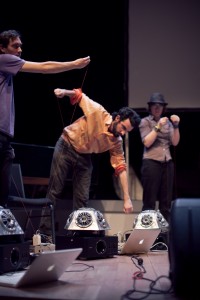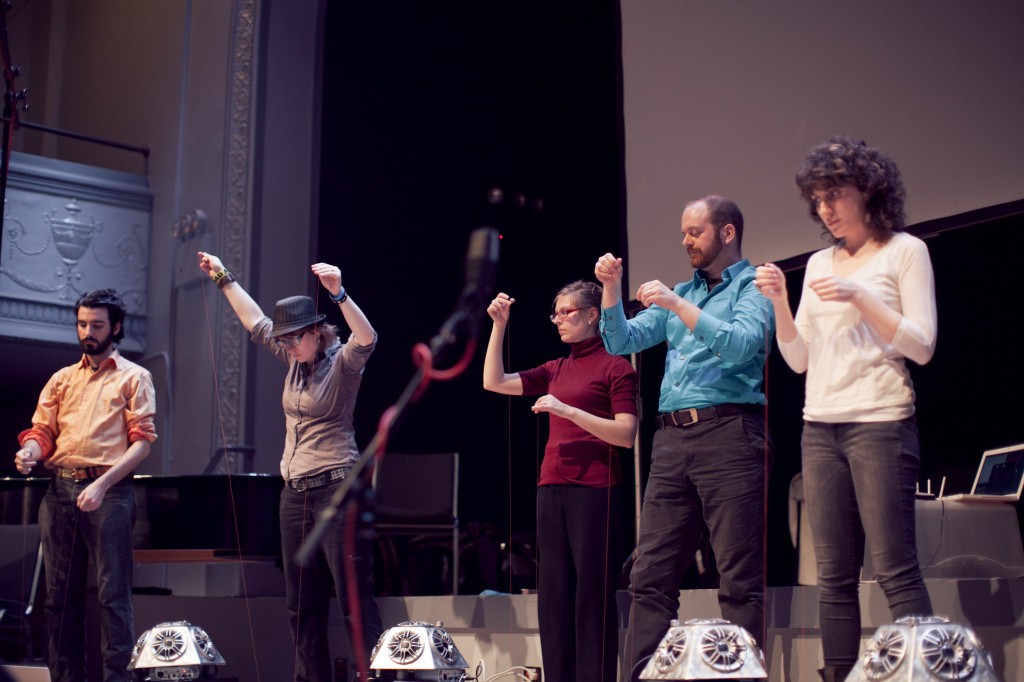
Jascha Narveson
In Line
About In Line:
This piece was my first to make use of Sideband’s now-famous “tether” instruments, the venerable Mad Catz Game Trak Real World Golf video-game controllers. I didn’t have a clear way in to writing this piece – I was lying awake one morning and picturing people playing the tethers like string-basses, and then imagined them gliding to different notes instead of plucking. The eventual shape of the instrument and the piece came by playing around with ideas in SuperCollider and building things up intuitively. The end result is nothing like playing string-basses.
How it works:
This piece has no set score – in some ways it’s more like a game that Sideband turned in to a performance piece by deciding on a consistent way of playing it. The core of the piece is a digital networked instrument that includes some game-like cause-and-effect interactions, driving how the piece works and how people behave while playing it. Musically, In Line is all about the contrast between streams of pulses (and what happens when those streams interact), and drones. Socially, In Line is a listening game.
The instrument has four states, the first one being “neutral,” which is inactive. Once a player grabs hold of the tether controller and stands up, the instrument is in “ticker” mode, and streams of pitches emerge, controlled by moving the two tethers around. When holding the tethers straight up and down, the player is in a common pulse with everyone else who’s also in that zone – moving the right hand from side to side breaks out of the communal pulse and in to a individual stream of pulses, while moving the other hand changes the sound in various ways (attack, reverb, etc…). Pitch and tempo are linked here, so the instrument produces characteristic melodies where higher notes are always faster, and lower notes are always slower.
Interesting side-note: I’ve noticed that this set-up leads people to a naturally lyrical style of playing, in the same way that using the tether controller in general can lead people to a naturally lyrical way of moving.
The next mode is “locked” mode, which happens when two players meet at the same tempo outside the common pulse. When this happens, their instruments lock on that tempo and the players’ right hands now control the phase of the beat (ie: where in the cycle the beat is happening). This is a listening game where the players try to line up where their beats are happening, and it takes a certain amount of attention to listen to both their pulses and your own. Once two players’ phases line up, a sparkly pinging sound announced the move to “drone” mode, and their instruments change into a rich, textured drone from which the only place to go is back to “neutral,” where they can start the whole process over again.
 How we play it:
How we play it:
The way Sideband has shaped this piece in rehearsal is by a very orderly introduction of soloists who then pair off and turn in to drones for the rest of the piece, so that at the end the final two soloists are playing over several layers of droning sound. The (accidentally) lyrical nature of the melodies combined with our established pattern of hearing only solo lines combined with drones reminds me of classical Indian music, without actually sounding too much like it. Although I wasn’t consciously thinking about Indian music while working on this piece, my many years of past study of both North and South Indian music still probably had a lot to do with the ultimate sound of the piece anyway.
How other people play it:
Other ways of playing In Line are possible, and David Code at Kalamazoo has the distinction of making the first “arrangement” of this piece in a performance by KLOrk (the Kalamazoo Laptop Orchestra).

Deprecated: Function get_magic_quotes_gpc() is deprecated in /hermes/bosnacweb01/bosnacweb01aj/b676/nf.jaschanarveson/public_html/sidebandchronicles/wp-includes/formatting.php on line 4358
Deprecated: Function get_magic_quotes_gpc() is deprecated in /hermes/bosnacweb01/bosnacweb01aj/b676/nf.jaschanarveson/public_html/sidebandchronicles/wp-includes/formatting.php on line 4358
Deprecated: Function get_magic_quotes_gpc() is deprecated in /hermes/bosnacweb01/bosnacweb01aj/b676/nf.jaschanarveson/public_html/sidebandchronicles/wp-includes/formatting.php on line 4358
Deprecated: Function get_magic_quotes_gpc() is deprecated in /hermes/bosnacweb01/bosnacweb01aj/b676/nf.jaschanarveson/public_html/sidebandchronicles/wp-includes/formatting.php on line 4358
Deprecated: Function get_magic_quotes_gpc() is deprecated in /hermes/bosnacweb01/bosnacweb01aj/b676/nf.jaschanarveson/public_html/sidebandchronicles/wp-includes/formatting.php on line 4358
Deprecated: Function get_magic_quotes_gpc() is deprecated in /hermes/bosnacweb01/bosnacweb01aj/b676/nf.jaschanarveson/public_html/sidebandchronicles/wp-includes/formatting.php on line 4358
Deprecated: Function get_magic_quotes_gpc() is deprecated in /hermes/bosnacweb01/bosnacweb01aj/b676/nf.jaschanarveson/public_html/sidebandchronicles/wp-includes/formatting.php on line 4358
Deprecated: Function get_magic_quotes_gpc() is deprecated in /hermes/bosnacweb01/bosnacweb01aj/b676/nf.jaschanarveson/public_html/sidebandchronicles/wp-includes/formatting.php on line 4358
Deprecated: Function get_magic_quotes_gpc() is deprecated in /hermes/bosnacweb01/bosnacweb01aj/b676/nf.jaschanarveson/public_html/sidebandchronicles/wp-includes/formatting.php on line 4358